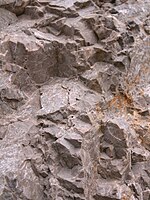
Photo from wikipedia
The creep of soft rocks induced by seepage-stress coupling is one of the critical factors that causes the failure of the rock. However, the actual failure mechanisms of soft rocks,… Click to show full abstract
The creep of soft rocks induced by seepage-stress coupling is one of the critical factors that causes the failure of the rock. However, the actual failure mechanisms of soft rocks, particularly during the accelerated creep stage, have not been fully understood so far. Therefore, the purpose of the present study is to develop theoretical models to quantitively investigate the effects of coupled fissure-pore seepage and hydro-mechanical coupling on the damage behavior of soft rocks. The evolution model of coupled fissure-pore seepage in soft rock was developed, and the coupled fissure-pore damage creep model of soft rock was established. The developed models were also validated by performing a series of triaxial experimental tests. The results show that the theoretical prediction agrees with the experimental results reasonably well. In addition, the developed hydro-mechanical coupled damage creep model for soft rocks can reproduce the experimentally observed deformation behavior of soft rocks in three different creep stages (i.e., deceleration creep, constant creep, and accelerated creep), respectively. Furthermore, the developed fracture evolution and pore index model have the capability of capturing the experimentally observed fracture propagation of soft rocks under hydro-mechanical conditions. The developed model could potentially be used as a useful tool for quantitatively analyzing the risks of soft rock disasters.
Journal Title: International Journal of Geomechanics
Year Published: 2020
Link to full text (if available)
Share on Social Media: Sign Up to like & get
recommendations!